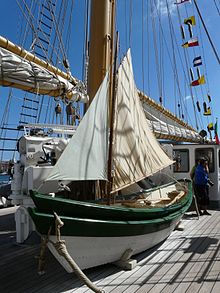Frota Branca
As Frota Branca or White Fleet (Portuguese or English for: White Fleet ) was the Portuguese fishing fleet indicated that for several centuries until the early 1970s on the Grand Banks of cod fished .
history
The Portuguese fishing off Newfoundland began after the seizure of Newfoundland by Gaspar Corte-Real in 1500. The emitted fishing fleet went every year for about six month fishing season (Portuguese: campanha ) and contributed over several hundred years a significant part of the diet and economic performance of Portugal at. At the beginning of the 20th century, a typical type of sailing ship emerged for this type of fishing, three or four-masted schooners with a pronounced round stem, the mostly white hulls and white sails of which led to the designation "White Fleet". The schooners were equipped with numerous dories , which were manned by one or two men and spread around the schooner. The dory was then fished with longlines or rods until the dory was full. The catch was brought back to the mother ship, where it was slaughtered and salted. The base port that was called at regular intervals during the fishing season to release catch and replenish supplies was St. John's .
In the period after World War II, the White Fleet comprised around 50 units. But after a large festival in St. John's in honor of the Portuguese bank fishermen had been celebrated in 1955, relations between Canada and Portugal deteriorated visibly against the background of years of overfishing due to increasingly industrialized fishing. On July 23, 1974 the schooner Novos Mares left the port of St. John's as the last ship of the Frota Branca, ending the centuries-old history of Portuguese bank fishing.
Four former logger of the White Fleet - the three-mast - Schonerbrigg Gazela (before Gazela Primeiro ., Year 1901) and the Viermast- Gaffelschoner Creoula (Bj. 1937), her sister ship Santa Maria Manuela and these very similar (built in 1937.) Argus ( Bj. 1938) - have survived to this day and remember, mostly restored, of the former era.
aftermath
The Australian writer Alan Villiers reported in his 1951 book The Quest of the Schooner Argus (German: Thousand Colorful Sails ) about his experiences on the schooner Argus .
See also
- Hospital ship of the "White Fleet": Gil Eannes (1)
- Hospital ship of the "White Fleet": Gil Eannes (2)
literature
- Jean-Piere Andrieux: The White Fleet. A history of Portuguese handliners , Flanker Press, St. John's 2013, ISBN 978-1-77117-236-3 .
- Priscilla Doel: Port O 'Call, Memories of the Portuguese White Fleet in St. John's, Newfoundland , Institute of Social and Economic Research, Memorial University of Newfoundland, St. John's, 1992.
Web links
Footnotes
- ↑ a b Giles MS Tod: Sail in '50 . In: Motor Boating , Volume 88, No. 6. Hearst Magazines, New York 1951. p. 13 ( Online . At books.google.de, accessed June 5, 2016)
- ↑ Gazela . Retrieved June 5, 2016 from philashipguild.org
- ↑ O Navio ( Memento of the original from June 1, 2016 in the Internet Archive ) Info: The archive link was inserted automatically and has not yet been checked. Please check the original and archive link according to the instructions and then remove this notice. . Retrieved June 5, 2016 from creoula.marinha.pt
- ↑ History ( Memento of the original from July 11, 2016 in the Internet Archive ) Info: The archive link was inserted automatically and has not yet been checked. Please check the original and archive link according to the instructions and then remove this notice. . Retrieved June 5, 2016 from santamariamanuela.pt
- ^ Teresa Firmino: Série Mar Português: pode um navio contar a história da pesca do bacalhau? . On September 7, 2012 on publico.pt





